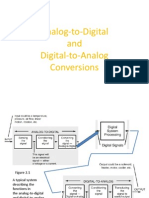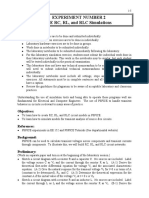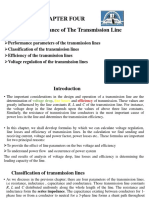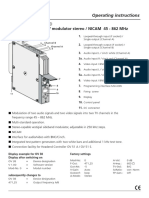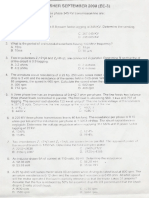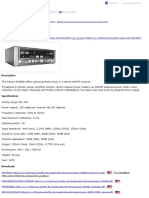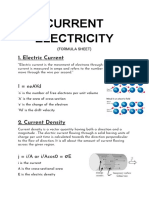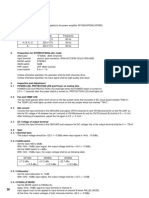0 ratings0% found this document useful (0 votes)
204 viewsLAB 1: Per Unit System in Transmission and Distribution
This document describes an electrical engineering lab experiment on per unit systems in power transmission and distribution. The experiment involves setting up and analyzing both radial and ring distribution network configurations using a training circuit. For the radial network, students measure voltages and currents across lamps and feeders in a simple system and with separate feeders. For the ring network, similar measurements are taken and compared to the radial network. The goal is for students to understand voltage and current profiles in different distribution system topologies.
Uploaded by
semuty92Copyright
© © All Rights Reserved
Available Formats
Download as PDF, TXT or read online on Scribd
0 ratings0% found this document useful (0 votes)
204 viewsLAB 1: Per Unit System in Transmission and Distribution
This document describes an electrical engineering lab experiment on per unit systems in power transmission and distribution. The experiment involves setting up and analyzing both radial and ring distribution network configurations using a training circuit. For the radial network, students measure voltages and currents across lamps and feeders in a simple system and with separate feeders. For the ring network, similar measurements are taken and compared to the radial network. The goal is for students to understand voltage and current profiles in different distribution system topologies.
Uploaded by
semuty92Copyright
© © All Rights Reserved
Available Formats
Download as PDF, TXT or read online on Scribd
You are on page 1/ 13
BEP/1314I
AMIR IZZANI MOHAMED @ FKEE UMP
Faculty of Electrical & Electronics Engineering
BEE3133 Electrical Power Systems
LAB 1: Per Unit System in Transmission and Distribution
Mapping CO,PO,Domain : CO4,PO11,P5
CO4: Assemble and analyze the circuit of distribution and transmission systems.
PO11: Utilize techniques, skills, and modern engineering tools necessary for engineering practice and
adaptable to industrial needs.
P5: Complex Overt Response
Learning Outcomes:
At the end of this experiment, students should be able to:
a) To demonstrate the principles of the commonly used radial system for low voltage
distribution networks.
b) To demonstrate the principles of ring distribution systems as used in low voltage
networks.
Experiment 1: Radial Distribution Systems
Introduction
Electricity suppliers normally use radial distribution in rural areas where the load is
randomly distributed, separated by areas with little or no habitation, and back up supplies
are normally not available. The length of feeder is typically limited to 500 m or less. In the
radial distribution system, feeders supplying the consumers are all fed from a central point
(the substation) as shown in Figure 1. There is no looping of the feeders.
Figure 1: Radial System of Feeders.
BEP/1314I
AMIR IZZANI MOHAMED @ FKEE UMP
Procedure A: Simple Radial System
1) Connect the circuit as shown in Appendix A.
2) The 0 to 30 Vac supply (substation), the loads (6 lamps), and the feeder (6 resistors-
with variable connected in series).
3) Adjust the six variable resistors to give 26 each by switching on the circuit and tuning
potentiometer to give minimum lamp brightness.
Note: A real 1 km length of feeder of 20 mm
2
cross-section gives approximately 1 . The
variable resistors connected in series represent a feeder of approximately 156 km
length.
4) Adjust the 0 to 30 Vac supply to 30 Vac and observe the brightness of the lamp. Measure
and record the voltage across each lamp in Table 1.
Table 1: Lamp Voltages
Lamps Voltage (V)
Lamp 1
Lamp 2
Lamp 3
Lamp 4
Lamp 5
Lamp 6
Procedure B: Voltage and Current in a Radial System
1) Connect the circuit as shown in Appendix B.
2) Switch on and record the current and voltage across each lamp (all lamps must be in
circuit) and the voltage drop along each section of feeder (with respect to supply end).
Switch off the supply. Record the result in Table 2 below.
Table 2: Result for Procedure B
Circuit
Number
Lamp Feeder
Measured
Voltage (V)
Measured
Current (A)
Voltage Drop
(V)
1
2
3
4
5
6
BEP/1314I
AMIR IZZANI MOHAMED @ FKEE UMP
Procedure C: Separate Feeders
Now consider the case where each lamp is feed by a separate feeder connected to the
supply. This can be represented on the trainer by connecting the lamp under consideration
to the return feeder via an ammeter leaving the link connector for the remainder of the
lamps unconnected. Appendix C shows the connection when the lamp 1 is fed through a
separate feeder.
1) Connect the circuit as shown in Appendix C.
2) Take the readings for the lamp current, lamp voltage and feeder voltage drop. Record
the result in Table 5. Repeat this step for each lamp.
Table 5: Separate Feeders
Circuit
Number
Lamp Feeder
Measured
Voltage (V)
Measured
Current (A)
Voltage Drop
(V)
1
2
3
4
5
6
BEP/1314I
AMIR IZZANI MOHAMED @ FKEE UMP
Experiment 2: Ring Distribution Systems
Introduction
This is commonly used in urban areas with high housing density. In such a system, LV cables
from neighbouring distribution substations are either looped together or are terminated
very close to one another where an interconnection of cables can be made. This system is
normally used when a high degree of reliability of load supply is required and back up
substations is made available. Figure 2 shows a schematic diagram for a ring distribution
network.
Figure 2: Ring Distribution Network.
Procedure A: Simple Ring System
1) Use the singe phase circuit of the Trainer and consider the two 0 to 30 Vac supplies
representing two substations.
2) Connect the power supply to the feeder from both ends as shown in Appendix D.
3) Adjust the six variable resistors to give 26 each by switching on the circuit and tuning
potentiometer.
4) Switch the power on and observe the brightness of the lamp. Measure and record the
voltage across each lamp in Table 6 below.
Table 6: Lamp Voltages
Lamps Voltage (V)
Lamp 1
Lamp 2
Lamp 3
Lamp 4
Lamp 5
Lamp 6
BEP/1314I
AMIR IZZANI MOHAMED @ FKEE UMP
Procedure B: Voltage and Current in a Ring System
1) Connect the circuit as shown in Appendix E.
2) Switch on and record the current and voltage across the Lamp 1 and the voltage across
the Resistor (feeder) 1. Switch the power off.
3) Use a link to connect Lamp 1 to the return feeder. Switch the power on and repeat the
current and voltage measurements of Lamp 2 and Resistor 2.
4) Record the result in Table 7 below.
Table 7: Voltage and Current Measurements
Circuit
Number
Lamp Feeder
Measured
Voltage (V)
Measured
Current (A)
Voltage Drop
(V)
1
2
3
4
5
6
BEP/1314I
AMIR IZZANI MOHAMED @ FKEE UMP
Results and Discussions.
Experiment 1: Radial Distribution System
Procedure A: Simple Radial System
1) Draw the circuit diagram obtained from the connection in Appendix A.
2) Observe and explain the brightness of each lamp.
3) Explain why the lamp brightness decreases as the distance from supply increases.
Procedure B: Voltage and Current in a Radial System
1) Draw the circuit diagram obtained from the connection in Appendix B
2) From the current readings obtained, use Kirchhoffs current nodal law and calculate the
current flowing in each feeder.
3) Calculate the voltage drop across each feeder. Record the results from (1) and (2) into
Table 3 below. Show your hand calculation.
Table 3: Calculated and Measured Currents and Voltages
Resistor
Number
Calculated
Current
Calculated
Voltage
Drop
Measured
Voltage
Drop
Error
1
2
3
4
5
6
4) Compare the calculated and measured voltages.
5) Using the results in Table 3, apply Kirchhoffs law and calculate the voltage across each
lamp. Record your calculation into Table 4. Compare the calculated and measured
voltages.
BEP/1314I
AMIR IZZANI MOHAMED @ FKEE UMP
Table 4: Lamp Voltages
Lamp
Number
Calculated
Voltage
Measured
Voltage
Error
1
2
3
4
5
6
6) Draw the relationship between the resistor number (feeder) and the voltage drop
across the resistor.
7) Considering each resistor to represent 26 km of a feeder of 20 mm
2
cross-sectional area,
plot the voltage drop profile for the feeder represent by the six variable resistors. The
voltage profile is the relationship between the total drops against the feeder length
measured from the substation.
8) Explain the relationship obtained.
Procedure C: Separate Feeders
1) Draw the circuit diagram obtained from the connection in Appendix C
2) Compare the voltage across each lamp and the feeder voltage drop in this case with
corresponding values when one feeder was used to supply the six lamps (Procedure B).
Explain the comparison.
3) Draw the relationship between the resistor number (feeder) and the voltage drop
across the resistor.
4) Explain the relationship obtained.
BEP/1314I
AMIR IZZANI MOHAMED @ FKEE UMP
Experiment 2: Ring Distribution System
Procedure A: Simple Ring System
1) Draw the circuit diagram obtained from the connection in Appendix D.
2) Observe and explain the brightness of each lamp.
3) Compare the lamp voltage with corresponding value obtained in the experiments for a
radial distribution network.
Procedure B: Voltage and Current in a Ring System
1) Draw the circuit diagram obtained from the connection in Appendix E.
2) Compare the measured lamp voltage, current and resistor voltage with the
corresponding measured values for the radial feeder from Experiment 1. Explain the
difference.
3) Use the current measurements taken in Table 7, apply Kirchhoffs current law and
calculate the current flowing in each resistor.
4) Compare the current flowing in each resistor with the corresponding values calculated
for the radial feeder in Experiment 1. Explain the difference.
5) Plot the voltage drop profile for the variable resistors and compare with the
corresponding profile for a radial system. Explain the difference (if any).
6) Which of the two distribution systems offer a higher load voltage and lower feeder
voltage drop? Explain the reason.
BEP/1314I
AMIR IZZANI MOHAMED @ FKEE UMP
Appendix A: Connection for Experiment 1 Procedure A
BEP/1314I
AMIR IZZANI MOHAMED @ FKEE UMP
Appendix B: Connection for Experiment 1 Procedure B
BEP/1314I
AMIR IZZANI MOHAMED @ FKEE UMP
Appendix C: Connection for Experiment 1 Procedure C
BEP/1314I
AMIR IZZANI MOHAMED @ FKEE UMP
Appendix D: Connection for Experiment 2 Procedure A
BEP/1314I
AMIR IZZANI MOHAMED @ FKEE UMP
Appendix E: Connection for Experiment 2 Procedure B
You might also like
- EEE 458 - Power System Protection LaboratoryNo ratings yetEEE 458 - Power System Protection Laboratory12 pages
- Simulation of Some Power System, Control System and Power Electronics Case Studies Using Matlab and PowerWorld SimulatorFrom EverandSimulation of Some Power System, Control System and Power Electronics Case Studies Using Matlab and PowerWorld SimulatorNo ratings yet
- Module2 - Generation of High Voltage - Current - HVENo ratings yetModule2 - Generation of High Voltage - Current - HVE44 pages
- Experiment # 09: Objective: To Study The Over Voltage Protection of DC Power Supply System (CLO 1) Apparatus100% (1)Experiment # 09: Objective: To Study The Over Voltage Protection of DC Power Supply System (CLO 1) Apparatus20 pages
- Practical No 1 Name M.Jawad Roll No 21Bsc01 Semester 4 Sir Bilal HussainNo ratings yetPractical No 1 Name M.Jawad Roll No 21Bsc01 Semester 4 Sir Bilal Hussain5 pages
- Example: A Three Phase Overhead Lines Has A Resistance & Reactance ofNo ratings yetExample: A Three Phase Overhead Lines Has A Resistance & Reactance of1 page
- ECE5500 Winter 2013 Power System Analysis Homework Assignment # 1 Due Date: January 15, 2013No ratings yetECE5500 Winter 2013 Power System Analysis Homework Assignment # 1 Due Date: January 15, 20135 pages
- ACTIVITY 1: Three Phase Alternator: Open-And Short-Circuit CharacteristicsNo ratings yetACTIVITY 1: Three Phase Alternator: Open-And Short-Circuit Characteristics17 pages
- 07-01-2022 - EEE3100S 2022 November EXAM - 2No ratings yet07-01-2022 - EEE3100S 2022 November EXAM - 26 pages
- EELE 202 Lab 6 AC Nodal and Mesh Analysis s14No ratings yetEELE 202 Lab 6 AC Nodal and Mesh Analysis s148 pages
- Analog-to-Digital and Digital-to-Analog ConversionsNo ratings yetAnalog-to-Digital and Digital-to-Analog Conversions20 pages
- Experiment - 5 Load Flow Analysis Using Power World SimulatorNo ratings yetExperiment - 5 Load Flow Analysis Using Power World Simulator1 page
- Polyphase Ac Circuit Short Questions With AnswerNo ratings yetPolyphase Ac Circuit Short Questions With Answer3 pages
- 2 Experiment PSPICE RC RL and RLC SimulationNo ratings yet2 Experiment PSPICE RC RL and RLC Simulation5 pages
- 05-Nonpilot OC Protection of Transmission LinesNo ratings yet05-Nonpilot OC Protection of Transmission Lines23 pages
- Electromechanics Lab: Lab Report Experiment 3: To Study Three - Phase Transformer ConnectionsNo ratings yetElectromechanics Lab: Lab Report Experiment 3: To Study Three - Phase Transformer Connections9 pages
- Ee 2351 Power System Analysis Anna University Question PaperNo ratings yetEe 2351 Power System Analysis Anna University Question Paper2 pages
- Sheet (8) Synchronous Machine Problem (1) :: SolutionNo ratings yetSheet (8) Synchronous Machine Problem (1) :: Solution5 pages
- Example 7: D Firas Mohamme Dr. Power Year Electrical 4No ratings yetExample 7: D Firas Mohamme Dr. Power Year Electrical 415 pages
- Bus Impedance Matrix in Faults CalculationsNo ratings yetBus Impedance Matrix in Faults Calculations38 pages
- "Bridge B2HZ" For The Control of A DC MotorNo ratings yet"Bridge B2HZ" For The Control of A DC Motor16 pages
- VTU Exam Question Paper With Solution of 15EE72 Power System Protection Dec-2019-Mrs. Geetanjali Pawanekar100% (1)VTU Exam Question Paper With Solution of 15EE72 Power System Protection Dec-2019-Mrs. Geetanjali Pawanekar8 pages
- Find R, I and V in The Circuit Shown in Figure Below.: Assignment 1No ratings yetFind R, I and V in The Circuit Shown in Figure Below.: Assignment 14 pages
- Find R, I and V in The Circuit Shown in Figure Below.: Assignment 1No ratings yetFind R, I and V in The Circuit Shown in Figure Below.: Assignment 14 pages
- Malaysia Political Situation After Event 13 Mei 1969No ratings yetMalaysia Political Situation After Event 13 Mei 19692 pages
- Barbican Juice: Bottle: 1 - RM 3.50 3 - RM10.00 Bottle + Ice: 1 - RM 4.00 Cup: 1 - RM2.00No ratings yetBarbican Juice: Bottle: 1 - RM 3.50 3 - RM10.00 Bottle + Ice: 1 - RM 4.00 Cup: 1 - RM2.001 page
- High Voltage Power Cable Splicing Terminating Brief BrochureNo ratings yetHigh Voltage Power Cable Splicing Terminating Brief Brochure14 pages
- Bee4173 - Power System Operation & ControlNo ratings yetBee4173 - Power System Operation & Control7 pages
- ĐỀ CƯƠNG THI TIẾNG ANH CHUYÊN NGÀNH ĐiệnNo ratings yetĐỀ CƯƠNG THI TIẾNG ANH CHUYÊN NGÀNH Điện4 pages
- MULTIPLE CHOICE (Choose The Letter That Corresponds To The Correct Answer)100% (1)MULTIPLE CHOICE (Choose The Letter That Corresponds To The Correct Answer)4 pages
- Sansui 9090DB Stereo AM - FM Receiver Manual - HiFi EngineNo ratings yetSansui 9090DB Stereo AM - FM Receiver Manual - HiFi Engine12 pages
- Simulation of Some Power System, Control System and Power Electronics Case Studies Using Matlab and PowerWorld SimulatorFrom EverandSimulation of Some Power System, Control System and Power Electronics Case Studies Using Matlab and PowerWorld Simulator
- Module2 - Generation of High Voltage - Current - HVEModule2 - Generation of High Voltage - Current - HVE
- Experiment # 09: Objective: To Study The Over Voltage Protection of DC Power Supply System (CLO 1) ApparatusExperiment # 09: Objective: To Study The Over Voltage Protection of DC Power Supply System (CLO 1) Apparatus
- Practical No 1 Name M.Jawad Roll No 21Bsc01 Semester 4 Sir Bilal HussainPractical No 1 Name M.Jawad Roll No 21Bsc01 Semester 4 Sir Bilal Hussain
- Example: A Three Phase Overhead Lines Has A Resistance & Reactance ofExample: A Three Phase Overhead Lines Has A Resistance & Reactance of
- ECE5500 Winter 2013 Power System Analysis Homework Assignment # 1 Due Date: January 15, 2013ECE5500 Winter 2013 Power System Analysis Homework Assignment # 1 Due Date: January 15, 2013
- ACTIVITY 1: Three Phase Alternator: Open-And Short-Circuit CharacteristicsACTIVITY 1: Three Phase Alternator: Open-And Short-Circuit Characteristics
- Analog-to-Digital and Digital-to-Analog ConversionsAnalog-to-Digital and Digital-to-Analog Conversions
- Experiment - 5 Load Flow Analysis Using Power World SimulatorExperiment - 5 Load Flow Analysis Using Power World Simulator
- Electromechanics Lab: Lab Report Experiment 3: To Study Three - Phase Transformer ConnectionsElectromechanics Lab: Lab Report Experiment 3: To Study Three - Phase Transformer Connections
- Ee 2351 Power System Analysis Anna University Question PaperEe 2351 Power System Analysis Anna University Question Paper
- Sheet (8) Synchronous Machine Problem (1) :: SolutionSheet (8) Synchronous Machine Problem (1) :: Solution
- Example 7: D Firas Mohamme Dr. Power Year Electrical 4Example 7: D Firas Mohamme Dr. Power Year Electrical 4
- VTU Exam Question Paper With Solution of 15EE72 Power System Protection Dec-2019-Mrs. Geetanjali PawanekarVTU Exam Question Paper With Solution of 15EE72 Power System Protection Dec-2019-Mrs. Geetanjali Pawanekar
- Power System Wide-area Stability Analysis and ControlFrom EverandPower System Wide-area Stability Analysis and Control
- Computer Aided Design of Electrical MachinesFrom EverandComputer Aided Design of Electrical Machines
- Find R, I and V in The Circuit Shown in Figure Below.: Assignment 1Find R, I and V in The Circuit Shown in Figure Below.: Assignment 1
- Find R, I and V in The Circuit Shown in Figure Below.: Assignment 1Find R, I and V in The Circuit Shown in Figure Below.: Assignment 1
- Malaysia Political Situation After Event 13 Mei 1969Malaysia Political Situation After Event 13 Mei 1969
- Barbican Juice: Bottle: 1 - RM 3.50 3 - RM10.00 Bottle + Ice: 1 - RM 4.00 Cup: 1 - RM2.00Barbican Juice: Bottle: 1 - RM 3.50 3 - RM10.00 Bottle + Ice: 1 - RM 4.00 Cup: 1 - RM2.00
- High Voltage Power Cable Splicing Terminating Brief BrochureHigh Voltage Power Cable Splicing Terminating Brief Brochure
- ĐỀ CƯƠNG THI TIẾNG ANH CHUYÊN NGÀNH ĐiệnĐỀ CƯƠNG THI TIẾNG ANH CHUYÊN NGÀNH Điện
- MULTIPLE CHOICE (Choose The Letter That Corresponds To The Correct Answer)MULTIPLE CHOICE (Choose The Letter That Corresponds To The Correct Answer)
- Sansui 9090DB Stereo AM - FM Receiver Manual - HiFi EngineSansui 9090DB Stereo AM - FM Receiver Manual - HiFi Engine




























